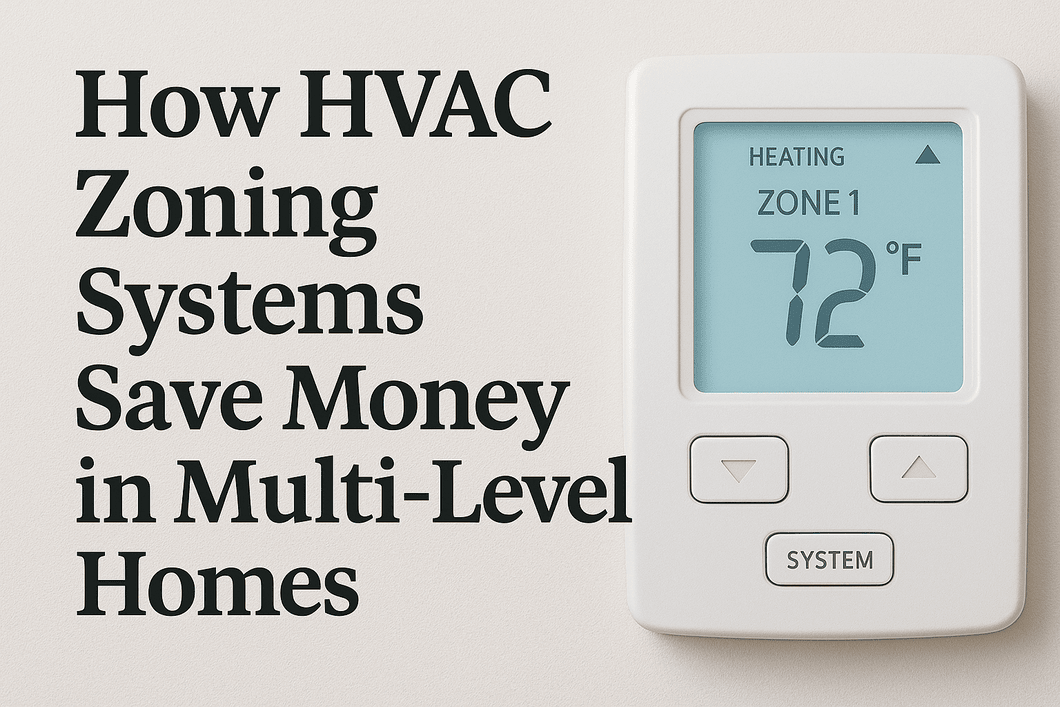In today’s energy-conscious world, homeowners are seeking smarter, more cost-effective ways to manage their home’s heating and cooling needs. One solution that stands out, especially in multi-level homes, is the installation of HVAC zoning systems. These systems are game changers for energy efficiency, comfort, and cost savings. Here’s an in-depth look at how HVAC zoning systems help homeowners save money while optimizing comfort.
What is an HVAC Zoning System?
An HVAC zoning system divides a home into separate areas or “zones”, each with its own thermostat and independent control. Instead of treating the entire house as a single climate unit, zoning allows individual temperature control for each zone. Dampers installed in the ductwork direct airflow only where it’s needed, making your system significantly more efficient.
Why Multi-Level Homes Need Zoning More Than Others
Multi-level homes typically experience uneven heating and cooling due to differences in sunlight exposure, insulation, and airflow resistance. For example:
- Upper floors often get hotter in the summer due to rising heat.
- Basements can stay cooler year-round.
- Main floors might face fluctuating temperatures due to frequent use and exterior doors.
With a traditional single-zone HVAC setup, maintaining a consistent temperature across all floors requires over-conditioning some areas, resulting in wasted energy and higher utility bills. Zoning solves this by customizing comfort per level.
Top Money-Saving Benefits of HVAC Zoning Systems
1. Lower Energy Bills Through Targeted Heating and Cooling
With zoning, you only heat or cool the areas you’re using. Why pay to condition empty guest rooms or storage spaces? By directing airflow to specific zones, your HVAC system runs less often and at lower capacity, leading to a significant drop in energy usage. Some homeowners report saving up to 30% on their energy bills after installing a zoning system.
2. Extended HVAC System Lifespan
By reducing the workload on your HVAC system, zoning helps prevent unnecessary wear and tear. The system doesn’t need to overwork to regulate the entire house’s temperature. This means:
- Fewer breakdowns
- Reduced maintenance costs
- Longer equipment lifespan
That translates into long-term financial savings and fewer emergency service calls.
3. Improved Comfort Without Overcompensation
Instead of cranking up the AC to cool the upstairs or blasting the heat to warm up the basement, each floor maintains its ideal temperature independently. This not only improves comfort but also prevents over-conditioning other zones, which typically leads to higher costs.
4. Greater Control = More Efficiency
Zoning systems work hand-in-hand with smart thermostats and automation tools. You can schedule temperatures for each zone based on time of day or occupancy. Heading to bed? Set the upstairs to cool while turning off airflow downstairs—all from your smartphone. Such control minimizes energy waste and maximizes savings.
Key Components of an HVAC Zoning System
To fully appreciate the cost-saving power of zoning, it’s essential to understand its components:
1. Zone Control Panel
This is the brain of the zoning system. It communicates between thermostats and dampers to control temperature regulation for each zone.
2. Thermostats
Each zone has its own programmable thermostat, allowing for independent control of heating and cooling.
3. Dampers
These are motorized valves installed inside the ducts. They open and close to regulate airflow to specific zones, based on thermostat settings.
4. HVAC Unit
Your existing HVAC system distributes the conditioned air, but with zoning, it does so strategically rather than uniformly.
Ideal HVAC Zoning Strategies for Multi-Level Homes
Zone by Floor
- Zone 1: Basement
- Zone 2: Ground Floor (Living areas, Kitchen)
- Zone 3: Upper Floor (Bedrooms, Office)
This layout ensures each floor is conditioned based on usage patterns and thermal behavior, leading to optimized energy consumption.
Zone by Function
- Day zones (living room, kitchen) active during daytime
- Night zones (bedrooms) active during night hours
- Rarely used zones (guest rooms, attics) set at minimal conditioning
This function-based zoning helps concentrate HVAC power where it matters most, further boosting efficiency.
HVAC Zoning vs. Traditional HVAC Systems
| Feature | Traditional HVAC | Zoning HVAC |
| Thermostat Count | One | Multiple |
| Comfort Control | Uniform across house | Individual zone control |
| Energy Efficiency | Lower | Higher |
| Initial Installation Cost | Lower | Higher |
| Long-Term Savings | Minimal | Significant |
| System Lifespan | Moderate | Extended |
Although the initial cost of a zoning system is higher, the ROI comes through monthly utility savings, reduced maintenance, and greater comfort.
Smart Zoning = Smart Home Investment
When integrated with smart home technology, zoning systems allow homeowners to:
- Adjust temperatures remotely
- Monitor energy consumption by zone
- Set energy-efficient schedules
- Receive maintenance alerts
All of this translates to precision control and lower costs.
Rebates and Incentives for Energy-Efficient HVAC Systems
Depending on your region, governments and utility companies often offer rebates or tax credits for upgrading to energy-efficient HVAC systems, including zoning installations. This makes it even more appealing to make the switch.
Professional Installation Matters
For the zoning system to deliver its promised savings, it must be properly designed and installed. We recommend working with licensed HVAC professionals who:
- Analyze your home’s structure
- Recommend optimal zone configurations
- Use high-quality components
- Ensure proper damper calibration
Cutting corners during installation can undermine the benefits and reduce efficiency.
Final Thoughts: Zoning is the Future of HVAC
HVAC zoning systems are a wise investment for any homeowner of a multi-level home. They offer a perfect blend of custom comfort, energy efficiency, and cost savings. With smarter control over your indoor climate, you no longer have to overpay for heating or cooling rooms you’re not using.
Whether you’re building a new home or upgrading an old system, zoning technology can transform your living experience—and your monthly utility bill.


